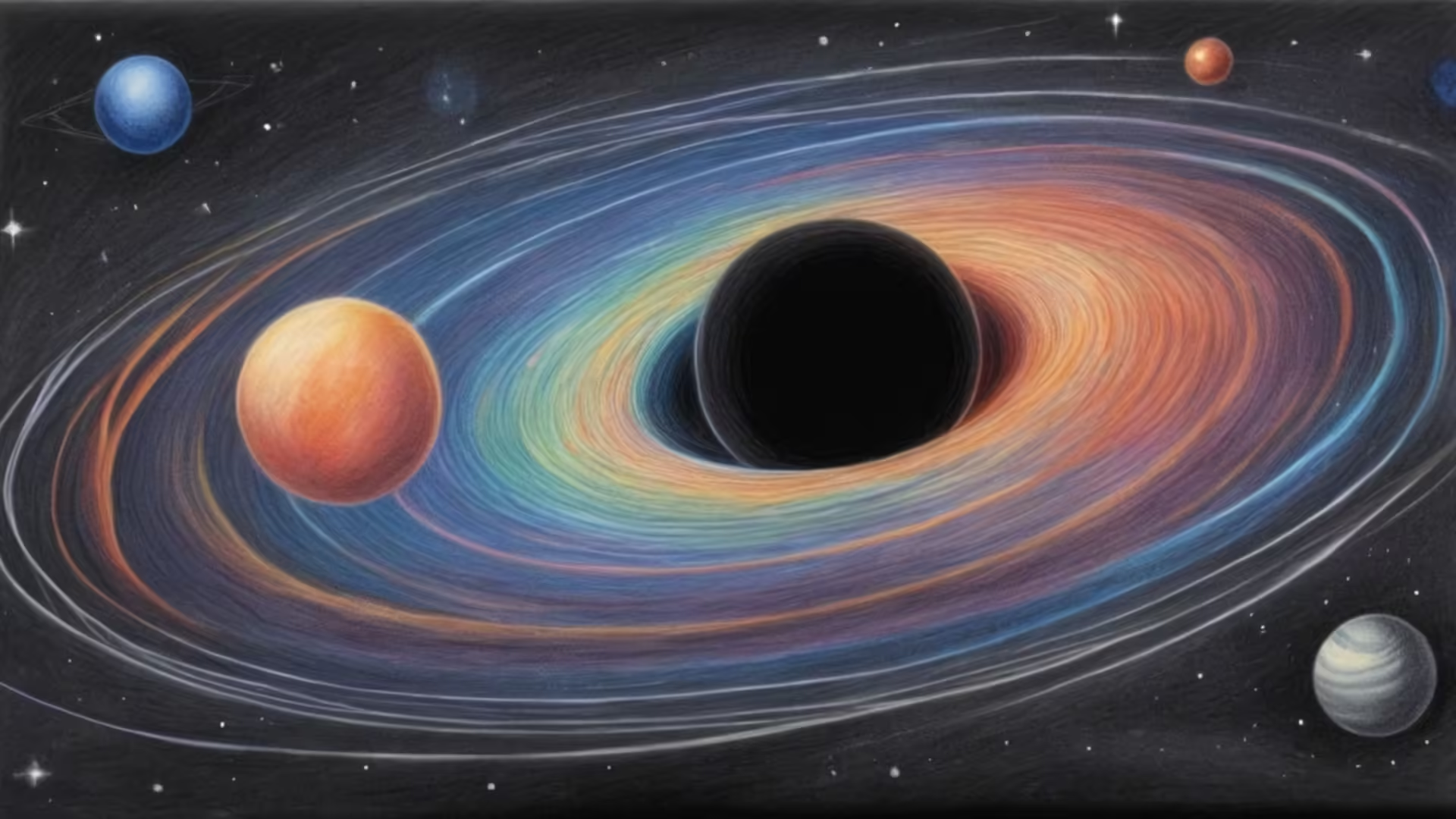- The Gist
- What is Space-Time?
- How Does Gravity Work in Space-Time?
- Black Holes: The Ultimate Warpers of Space-Time
- Time Dilation: How Space-Time Affects Time
- Space-Time and the Possibility of Time Travel
- Space-Time and the Expanding Universe
- Space-Time in Everyday Life
- Why Understanding Space-Time Matters
- Embracing the Mysteries of Space-Time
- Let’s Talk
- Let’s Learn Vocabulary in Context
The Gist
What is Space-Time?
Space-time is a concept that combines space (the three dimensions we move through) and time (the fourth dimension) into a single, four-dimensional framework. Instead of seeing space and time as separate, space-time weaves them together, creating the “fabric” of the universe. This idea was developed in the early 20th century, with Albert Einstein’s theory of general relativity showing how space-time isn’t fixed—it can be warped and bent by massive objects, creating the phenomenon we know as gravity.
Think of space-time as a flexible fabric, like a rubber sheet. When you place a heavy object on this sheet, it causes a dip, curving the surface around it. Now imagine that objects like stars, planets, and galaxies create dips in the fabric of space-time, influencing the paths of objects nearby. This bending of space-time by massive objects is what we experience as gravitational pull, drawing smaller objects toward them.
How Does Gravity Work in Space-Time?
Before Einstein, gravity was understood as a force that pulled objects toward each other. Isaac Newton’s laws described how gravity worked but didn’t explain why it worked. Einstein’s theory of general relativity provided a new perspective: gravity isn’t just a force—it’s the result of objects following the curved paths created by the warping of space-time.
When an object like Earth sits in space-time, it creates a curve that pulls objects, like the Moon or satellites, into orbit around it. Rather than being “pulled,” these objects are actually following the curve in space-time created by Earth’s mass. This idea reshaped our understanding of the universe, showing that massive objects can influence space-time itself, impacting the movement of everything around them.
Black Holes: The Ultimate Warpers of Space-Time
Black holes are some of the most extreme examples of space-time distortion. Formed when massive stars collapse under their own gravity, black holes create such intense curvature in space-time that not even light can escape them. At the center of a black hole lies what’s called a “singularity,” a point of infinite density where space and time as we know them break down.
The boundary around a black hole, known as the event horizon, marks the point of no return. Once anything crosses this boundary, it’s pulled into the black hole and can’t escape. This extreme warping of space-time not only challenges our understanding of gravity but also raises questions about the nature of time and space at a fundamental level.
Time Dilation: How Space-Time Affects Time
One of the fascinating implications of space-time is the phenomenon of time dilation, where time moves differently depending on the speed you’re traveling or the strength of gravity around you. According to Einstein’s theory, time slows down near massive objects. This effect, known as gravitational time dilation, means that if you’re close to a massive object, like a black hole, time would pass more slowly for you than for someone further away.
Similarly, if you travel at speeds close to the speed of light, time would slow down compared to someone who is stationary. This idea has been confirmed by experiments and even affects technology we use daily. For example, satellites in space experience a slight time dilation compared to people on Earth, so systems like GPS must account for these differences to provide accurate data.
Space-Time and the Possibility of Time Travel
Space-time’s flexibility has fueled a lot of curiosity about time travel. While we haven’t discovered a practical way to move back and forth through time, the concepts of space-time suggest it might not be entirely impossible. Theoretical physicists have proposed ideas like wormholes, which are hypothetical “tunnels” through space-time that could connect distant points in the universe—or potentially even different times.
In theory, wormholes could allow someone to travel vast distances across space or even skip to a different point in time. However, wormholes are still theoretical and haven’t been observed in reality. The study of space-time continues to inspire exploration into the nature of time, raising the possibility of time travel as more than just science fiction.
Space-Time and the Expanding Universe
Space-time also plays a role in the expansion of the universe. Since the Big Bang, space-time itself has been expanding, causing galaxies to move away from each other. This expansion is happening at every point in space, meaning that the universe doesn’t have an “edge”—instead, space-time is stretching, creating more distance between galaxies over time.
The discovery of the universe’s expansion led to the theory of dark energy, an unknown force driving the accelerated expansion of space-time. Dark energy remains one of the biggest mysteries in modern physics, and understanding it could provide more insights into the nature of space-time and the fate of the universe.
Space-Time in Everyday Life
Though space-time may seem like an abstract concept, it actually plays a role in our everyday lives. Technologies like GPS rely on an understanding of space-time to function accurately. Since satellites orbiting Earth experience time slightly differently due to their speed and distance from Earth’s gravitational field, their clocks run at a slightly different rate than those on Earth. GPS systems account for this time dilation to give accurate location data.
Space-time also helps us understand natural phenomena like gravitational waves—ripples in space-time caused by massive objects moving, like merging black holes. In 2015, scientists detected these waves for the first time, confirming another aspect of Einstein’s theory and opening up a new way to observe the universe.
Why Understanding Space-Time Matters
Studying space-time isn’t just about abstract theory—it’s about understanding the fundamental structure of reality. Space-time helps explain everything from how planets orbit the Sun to the mysteries of black holes and the potential for time travel. It shapes our understanding of the universe, from the smallest particles to the largest galaxies. As scientists continue to study space-time, we get closer to answering some of the biggest questions about existence, reality, and our place in the cosmos.
Embracing the Mysteries of Space-Time
Space-time is more than just a scientific concept—it’s the foundation of our universe, shaping everything we experience. From the bending of gravity to the potential for time travel, space-time invites us to explore reality’s deepest layers. Although many mysteries remain, each discovery about space-time brings us closer to understanding the universe we call home. Whether through the wonders of black holes or the time adjustments of a GPS, space-time touches our lives in ways we might not even realize. Exploring this fabric of the universe reminds us that there’s always more to discover, and sometimes, the answers are woven right into the fabric of space and time itself.
Let’s Talk
So, space-time—the fabric of the universe itself! Isn’t it wild to think that everything we experience, from the movement of planets to the ticking of our watches, is all tied up in this flexible fabric that can bend, stretch, and even twist? I don’t know about you, but it makes me wonder how reality itself is a lot more complex than it seems on the surface.
One of the coolest ideas to me is that space and time aren’t these separate things, but rather intertwined. It’s like they’re part of the same cosmic dance, influencing each other in ways that shape everything around us. Think about it: if time moves slower when you’re close to a massive object, like a planet or a black hole, does that mean you could theoretically age more slowly? Imagine taking a trip to a massive planet, hanging out near the edge of a black hole (just for fun, of course), and coming back to Earth to find out you’ve aged less than everyone else! Sounds like something straight out of a sci-fi movie, right?
And speaking of time, the concept of time dilation is both mind-blowing and a little bit of a head-scratcher. The fact that time literally flows differently depending on where you are or how fast you’re moving is pretty surreal. Ever been on a long flight and felt like time was moving at a crawl? Well, technically, time did pass a tiny bit slower for you while you were zooming through the sky compared to someone standing on solid ground. Granted, we’re talking nanoseconds, but it’s a real effect, and it’s actually something scientists have to account for with GPS satellites. Without those corrections, our navigation systems would be way off. Isn’t that amazing? We rely on space-time adjustments just to find the nearest coffee shop!
Then there’s the whole idea of black holes. I mean, black holes are like the rock stars of space-time, right? They bend it so drastically that they create what we call a “singularity,” where all our usual rules break down. Imagine being so massive that you can actually “rip” space-time to the point where even light can’t escape. It makes you wonder—are black holes just cosmic vacuum cleaners, or is there something on the other side? Scientists have even theorized about wormholes, which could theoretically connect two points in space-time. So, what if black holes are like entrances, just waiting for us to figure out what’s on the other side? It’s enough to make anyone’s head spin!
But let’s bring it back to our daily lives for a second. I know we don’t feel space-time bending as we walk down the street, but the fact that we’re affected by it, even in tiny ways, is a reminder of how connected everything is. It’s like space-time is this invisible web holding everything together. Maybe we’re not time-traveling through black holes, but every moment we experience is part of that same cosmic fabric. And who knows? Maybe the next time you glance at a clock, you’ll think about how time itself is bending and flexing around you in ways you can’t even see.
So, what do you think? Would you want to take a trip near a black hole just to see if you’d come back a little younger? Or maybe you’d like to figure out how GPS works now that you know space-time tweaks are involved? It’s fascinating to think about, isn’t it?
Let’s Learn Vocabulary in Context
Let’s explore some of the key words and phrases we came across in talking about space-time. These terms can be fascinating in scientific discussions, but they’re also handy in everyday life when talking about things that are beyond the ordinary or help us explain complex ideas in a simpler way.
First up, we have space-time. Space-time is the concept that combines space (where things exist) and time (when things happen) into one “fabric” that holds our universe together. In everyday conversations, you might hear someone say, “It feels like I lost all sense of space and time on vacation!” meaning they felt completely free and relaxed.
Next is fabric. When we talk about space-time as the fabric of the universe, we’re thinking of it as something flexible and interconnected. We use “fabric” to describe the underlying structure of things, like, “The family is the fabric of society,” suggesting it’s a key part of how things work.
Gravity is a familiar word, and it’s the force that pulls objects toward each other. In space-time, gravity is seen as the effect of massive objects bending space-time. You might use it in a more metaphorical way, like, “The gravity of the situation hit me,” meaning the importance or seriousness of something.
Curvature is the way something bends. In the context of space-time, massive objects create curvature by bending the “fabric” around them. Imagine saying, “The road curved sharply,” to describe how something veers or bends from a straight path.
Now for black hole. A black hole is a region of space with such strong gravity that not even light can escape it. While we usually use it to talk about space, you might hear someone call a messy drawer or endless project a “black hole” to mean it’s absorbing everything with no end in sight!
Singularity is a point where things break down or reach infinity. In black holes, singularities are points of infinite density. Outside of science, people might say, “That artist has a singularity of style,” meaning they’re uniquely original or different.
Event horizon is the boundary around a black hole where things can’t escape. You can use this term to describe a point of no return in other contexts, too. For example, “Once we missed the deadline, we crossed the event horizon,” meaning there was no way back.
Then there’s time dilation. Time dilation happens when time moves slower or faster depending on speed or gravity. In real life, people might use it humorously, like, “Waiting in line felt like time dilation was in full effect,” to describe something that felt like it lasted forever.
Wormhole is a theoretical “tunnel” in space-time that could connect distant points. While we haven’t proven they exist, you could say, “That shortcut was like a wormhole through traffic,” meaning it made a long journey feel much shorter.
Finally, we have expansion. In space, the expansion of the universe means everything is moving further apart. We also use expansion to talk about growth or spreading out, like, “Our company’s expansion into new markets is exciting,” which means they’re growing their reach.
Here are a couple of questions to think about: Have you ever felt like you were in a “black hole” situation that seemed endless? And do you think we’ll ever find a real “wormhole” in our universe?










0 Comments